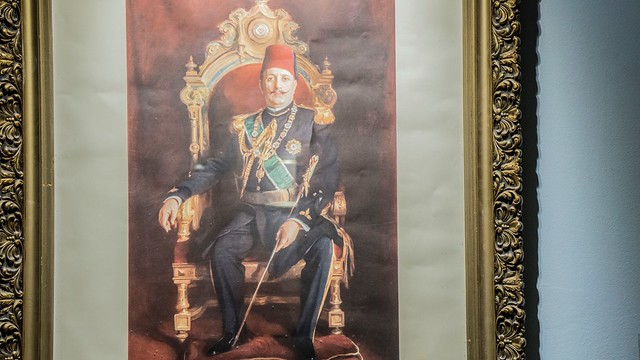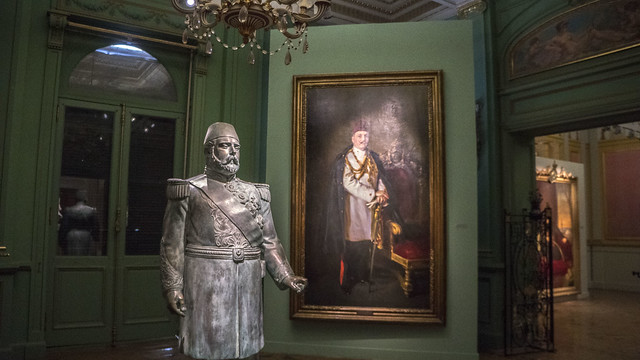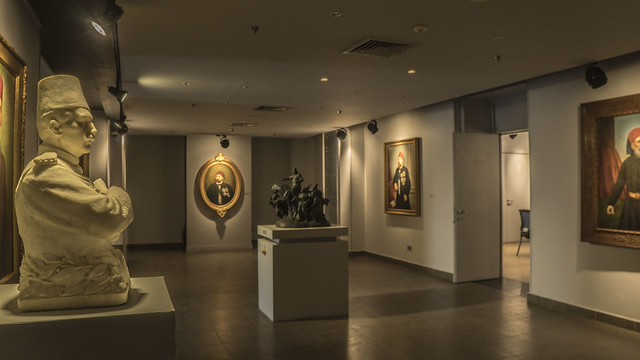This is the second part of my photo-series about my visit to The features of an era “Mohamed Ali Royal Dynasty” edition that was held in March 2019 at Aisha Fahmy Palace aka “Al-Gazeira Centre of Arts". You can check the first part of the series here.
I am still trying to hijack the Mohamed Ali whistleblower trend as he is back this time in the international media with interviews in BBC, NY Times and Guardian. There is a new round of interviews coming on the way by him as it seems.
He held a very raising eye-brow press conference in London calling for some revolution/peaceful-transition of power/referendum/reconciliation which many are puzzled with back home.
In the end, it is kind of ironic that Ali is the only vocal opposition figure in Egypt.
Back to the original Mohamed Ali and his dynasty in that exhibit.
There are lots of beautiful stuff in that exhibit that could not be presented in a single post.
Aside from the very well crafted paintings and busts as well as the statues featuring the rulers of Mohamed Ali Royal family rulers, there were awkward artworks in the exhibit too.
Like that marble bust made Mohamed Ali Pasha look like Egyptian actor Yahia El-Fakhrany "The veteran Egyptian actor wanted to play him on-screen" for real or like a kind old Druze religious man in the mount of Lebanon or Syria not like a man who built a modern state in the 19th century restlessly and violently. "Democracy and human rights were not on his agenda but it was the early 19th century and those two words were strange to the East"
Now that's a painting to Mohamed Ali we used to know from history books along with his son Khedive Ismail.
One of the things that I like about this exhibit is that it featured also the members of the Mohamed Ali royal family that are not that famous to the public.
Like for instance, Mohamed Ali’s eldest son Tusun pasha when he was a young boy.
Yes, that was the founder of modern Egypt’s eldest son unlike what is commonly known that Ibrahim pasha was his eldest son.
A skilled military commander who played a role in the wars of the Ottomans against the Wahabis in Arabia aka Saudi Arabia now in the early 19th century, he was fated to rule Egypt after Mohamed Ali. Fate had another word because the young military skilled commander died at the age of 23 only in Cairo in 1816 because of the plague.
Tusun pasha was the father of the eccentric Abbas Helmi I
Here is another portrait of Ibrahim Pasha who ended up Egypt’s ruler.
There was also a 19th-portrait for less known for his half brother Hussein Bey.
Hussein Mohamed Ali is one of Mohamed Ali’s sons from his consort Mumtaz Qadin. He died in 1867.
That portrait was painted by French Benoît-Hermogaste Molin whom I guess that he made several portraits for Mohamed Ali family that was included in the exhibit like teen Khedive Ismail judging from the same style.
There was also a beautiful portrait for Prince Omar Tusun
The grandson of Khedive Said, Prince Omar Tusun is my most favorite royal figure in Mohamed Ali Royal Family.
This handsome man’s contribution to Egypt’s political, cultural and historical heritage in the 20th century can’t be listed in a few lines.
It is enough to say that that man who had unofficially the title "Prince of Alexandria" supported Egypt’s quest independence and actually was behind the idea of sending a delegation of Egyptian politicians to demand the country’s independence at the Paris Peace Conference aka Versailles Peace conference in 1919 after World War I, the rest is history. “We had a revolution in 1919 after the arrest of this delegation’s members and sending them in exile”.
This handsome man was an amateur archeologist who had his own discoveries especially when it comes to old and ancient monasteries.
The prince also donated a part of the land he owned in Alexandria to built Egypt’s famous Greco-Roman museum. Omar Tusun also donated and supported the renovation of many of Cairo’s ancient mosques in old Cairo.
A skilled author, he wrote down several books in history and geography.
A whole paragraph is not enough to give this man his right. For me, he is 100% Egyptian.
His great-granddaughter Melekper Tusun came to Egypt in March and visited the exhibit. She praised the exhibit and had something to say about it.
Now to the last official kings of Egypt and Sudan, the father and son.
King Fouad I was the first in the Mohamed Ali dynasty to be called a King and so for that, you would find many statues, photos and paintings.
There was a painted version from that very rare color of King Fouad I in the exhibit.
Interestingly starting with King Fouad I, we began to see Egyptian artists joining the Royal court artists producing artworks glorifying their king just like their ancestors during the ancient Egyptians.
Famous Egyptian sculptor Mostafa Matwally signed that granite plate in Arabic featuring the face of King Fouad I in 1931.
That was not the only artwork signed by Mostafa Matwally in the exhibit, in fact of his most famous artworks that many to be lost years ago remerged in the exhibit. That piece of artwork was the bronze statue of Khedive Ismail which was planned to be installed at Ismail Square aka Tahrir square in Cairo.
That statue project was announced in the late 1940s as a commemoration to Khedive Ismail, King Farouk's grandfather and the famous Egyptian sculptor was commissioned to do but then the July 1952 coup d' etat and Ismail square became Tahrir square.
Already Matwally finished the statue but suddenly it disappeared and its disappearance puzzled Egyptian artists for decades but then reappeared in 2019 for the first time to the public.
Historically during Fouad I's rule or rather following the 1919 revolution and the declaration of Egypt's semi-independence in 1922, there was a birth movement of Egyptian arts. That era actually gave birth to Egypt's greatest artists, sculptors, musicians, novelists, architects and the list goes on.
Back to King Fouad I, I found his awkward bust and It reminded me of the infamous Cristiano Ronaldo bronze statue for some reason
Many of King Fouad's oil paintings were made by Hungarian Painter Philip de Laszlo, I do not know if that painting was one of them or not.
Judging from de Laszlo, I can say it can be his.
According to various tales, strict King Fouad I told his son Crown Prince Farouk when he was a boy that he would be ousted because of “fooling around”.
Despite being abusive husband, King Fouad I was damn right
Now if the unfinished portrait of King Farouk I was one of the most beautiful pieces I saw in the exhibit, that painting also stands out.
King Farouk I of Egypt and Sudan standing looking to the sea while on abroad of some Egyptian warship.
It is updated painting but judging from Farouk’s appearance, I would say that it was commissioned and made shortly before 1952.
On 26 July 1952 Farouk abdicated the throne to his baby son Ahmed Fouad II and left Egypt from Alexandria for one last trip with no return to Capri on the Royal Yacht Al-Mahrousa.
He could have resisted and ordered the rest of the army units and police forces to turn against the Free officers but he did not.
He could have asked the help of the British forces in Suez but he did not.
It is said that the former King sai that the Egyptian blood for him was more precious than all the thrones of the world and he would not let spill.
"I hope you fix what I failed in doing" King Farouk was overheard saying to General Mohamed Naguib before getting on the board of Al-Mahrousa and selling away.
I think it is a big secret that the free officers failed in their own unique way to the level that Egypt and the Arab region are still paying heavily because of their failure.
After abdicating the throne and leaving to exile with his baby son, a king regent was appointed for a short time before the declaration of the Egyptian Republic in March 1953. That King regent was Prince Mohamed Abdel Monem, the son of Khedive Abbas Helmi II.
Here is a very beautiful painting for when he was a Petit Prince by Swiss painter Otto Pilny in 1904.
I think this painting was commissioned at the same time, little Mohamed Abdel Monem was photographed with his sisters when his father was the Khedive and he was his crown prince.
So far the so-called 1952 Revolution Museum has not been inaugurated yet so the world would see more of these artifacts and artworks documenting a bygone era in a small way.
For the current time, you can check Egyptian Chronicles for a small glimpse of this bygone era.
Here is Another shaky awful Quick Camera Tour showing the exhibit in less than 2 minutes.
This is not the end of this series about this exhibit because there are still photos from the exhibit that I have not uploaded yet.
They are photos from that tiny partition dedicated to the women of Mohamed Royal Family, mostly from the less known 19th century Mohamed Ali's Dynasty women. This needs another post and another chronicle.
I am still trying to hijack the Mohamed Ali whistleblower trend as he is back this time in the international media with interviews in BBC, NY Times and Guardian. There is a new round of interviews coming on the way by him as it seems.
He held a very raising eye-brow press conference in London calling for some revolution/peaceful-transition of power/referendum/reconciliation which many are puzzled with back home.
In the end, it is kind of ironic that Ali is the only vocal opposition figure in Egypt.
Back to the original Mohamed Ali and his dynasty in that exhibit.
There are lots of beautiful stuff in that exhibit that could not be presented in a single post.
 |
| Egypt's Mohamed Ali Family tree in the 19th century |
 |
| Mohamed Ali Pasha looked like a sweet granddad here |
Now that's a painting to Mohamed Ali we used to know from history books along with his son Khedive Ismail.
 |
| The father and Son, Mohamed Ali Pasha in painting and Khedive Ismail as a bust |
Like for instance, Mohamed Ali’s eldest son Tusun pasha when he was a young boy.
 |
| Tusun Pasha as a boy |
A skilled military commander who played a role in the wars of the Ottomans against the Wahabis in Arabia aka Saudi Arabia now in the early 19th century, he was fated to rule Egypt after Mohamed Ali. Fate had another word because the young military skilled commander died at the age of 23 only in Cairo in 1816 because of the plague.
Tusun pasha was the father of the eccentric Abbas Helmi I
Here is another portrait of Ibrahim Pasha who ended up Egypt’s ruler.
 |
| Ibrahim Pasha's portrait |
 |
| Hussein Bey, son of Mohamed Ali Pasha |
That portrait was painted by French Benoît-Hermogaste Molin whom I guess that he made several portraits for Mohamed Ali family that was included in the exhibit like teen Khedive Ismail judging from the same style.
There was also a beautiful portrait for Prince Omar Tusun
 |
| Handsome Prince of Alexandria Omar Tusun. |
This handsome man’s contribution to Egypt’s political, cultural and historical heritage in the 20th century can’t be listed in a few lines.
It is enough to say that that man who had unofficially the title "Prince of Alexandria" supported Egypt’s quest independence and actually was behind the idea of sending a delegation of Egyptian politicians to demand the country’s independence at the Paris Peace Conference aka Versailles Peace conference in 1919 after World War I, the rest is history. “We had a revolution in 1919 after the arrest of this delegation’s members and sending them in exile”.
This handsome man was an amateur archeologist who had his own discoveries especially when it comes to old and ancient monasteries.
The prince also donated a part of the land he owned in Alexandria to built Egypt’s famous Greco-Roman museum. Omar Tusun also donated and supported the renovation of many of Cairo’s ancient mosques in old Cairo.
A skilled author, he wrote down several books in history and geography.
A whole paragraph is not enough to give this man his right. For me, he is 100% Egyptian.
His great-granddaughter Melekper Tusun came to Egypt in March and visited the exhibit. She praised the exhibit and had something to say about it.
Now to the last official kings of Egypt and Sudan, the father and son.
 |
| The last two official kings of Egypt and Sudan: Fouad I and Farouk I |
 |
| A colored photograph of King Fouad I |
Interestingly starting with King Fouad I, we began to see Egyptian artists joining the Royal court artists producing artworks glorifying their king just like their ancestors during the ancient Egyptians.
 |
| The face of King Fouad I engraved on granite in 1931 by famous Egyptian sculptor Mostafa Metwally |
That was not the only artwork signed by Mostafa Matwally in the exhibit, in fact of his most famous artworks that many to be lost years ago remerged in the exhibit. That piece of artwork was the bronze statue of Khedive Ismail which was planned to be installed at Ismail Square aka Tahrir square in Cairo.
 |
| Khedive Ismail's bronze state by Mostafa Matwally and behind it an oil painting for his son King Fouad I |
Already Matwally finished the statue but suddenly it disappeared and its disappearance puzzled Egyptian artists for decades but then reappeared in 2019 for the first time to the public.
 |
| The statue of Khedive Ismail between the paintings of his brother Khedive Saeed and his son King Fouad I |
Back to King Fouad I, I found his awkward bust and It reminded me of the infamous Cristiano Ronaldo bronze statue for some reason
 |
| Another bronze statue bust for King Fouad I of Egypt and Sudan |
 |
| King Fouad I on the throne of Egypt oil painting |
According to various tales, strict King Fouad I told his son Crown Prince Farouk when he was a boy that he would be ousted because of “fooling around”.
 |
| One of King Fouad I's official portraits in the exhibit, I think he was photographed by Riyadh Pasha Shehata |
Now if the unfinished portrait of King Farouk I was one of the most beautiful pieces I saw in the exhibit, that painting also stands out.
 |
| King Farouk's painting |
It is updated painting but judging from Farouk’s appearance, I would say that it was commissioned and made shortly before 1952.
 |
| The face of King Farouk engraved on a marble plate in 1936 by an Egyptian sculptor |
 |
| The official King Farouk's portrait by Riyadh Pasha Shehata in 1936 when he crowned |
He could have asked the help of the British forces in Suez but he did not.
It is said that the former King sai that the Egyptian blood for him was more precious than all the thrones of the world and he would not let spill.
"I hope you fix what I failed in doing" King Farouk was overheard saying to General Mohamed Naguib before getting on the board of Al-Mahrousa and selling away.
I think it is a big secret that the free officers failed in their own unique way to the level that Egypt and the Arab region are still paying heavily because of their failure.
After abdicating the throne and leaving to exile with his baby son, a king regent was appointed for a short time before the declaration of the Egyptian Republic in March 1953. That King regent was Prince Mohamed Abdel Monem, the son of Khedive Abbas Helmi II.
Here is a very beautiful painting for when he was a Petit Prince by Swiss painter Otto Pilny in 1904.
 |
| Prince Mohamed Abdel Monem in his childhood by Swiss painter Otto Pilny |
I think this painting was commissioned at the same time, little Mohamed Abdel Monem was photographed with his sisters when his father was the Khedive and he was his crown prince.
So far the so-called 1952 Revolution Museum has not been inaugurated yet so the world would see more of these artifacts and artworks documenting a bygone era in a small way.
 |
| Features of an era exhibit |
Here is Another shaky awful Quick Camera Tour showing the exhibit in less than 2 minutes.
This is not the end of this series about this exhibit because there are still photos from the exhibit that I have not uploaded yet.
They are photos from that tiny partition dedicated to the women of Mohamed Royal Family, mostly from the less known 19th century Mohamed Ali's Dynasty women. This needs another post and another chronicle.

No comments:
Post a Comment
Thank You for your comment
Please keep it civilized here, racist and hateful comments are not accepted
The Comments in this blog with exclusion of the blog's owner does not represent the views of the blog's owner.